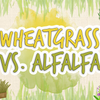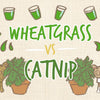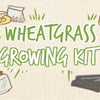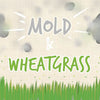Freezing Wheatgrass: The Comprehensive Guide
Part of the allure that attracts most people to sprouts and microgreens is the promise of growing your own superfoods indoors. Unfortunately, sprouts and microgreens have such a short shelf life that they will immediately start losing their flavor and texture the moment they are harvested. This calls for a convenient storage method; in this case, freezing will serve that purpose. This guide will take you through all the prerequisites in freezing wheatgrass, how to do it, and the various methods you can rely on.
Not Much Time? Skip To What You'd Like To Learn...
-
What Is Wheatgrass?
-
What Is Freezing?
-
Why Freeze Wheatgrass?
-
Different Forms Of Wheatgrass That Can Be Frozen
-
Types of Wheatgrass You Can't Freeze
-
Freeze Drying Vs Freezing Vs Flash Freezing
-
How To Freeze Wheatgrass Juice And Shots
-
How To Freeze Fresh Wheatgrass
-
How To Defrost Your Wheatgrass
-
Common Questions
What Is Wheatgrass?
Wheatgrass refers to freshly sprouted wheat shoots which are 6 to 10 days old. The sprouting process kicks off with a 12-hour prolonged activation soak followed by regular rinsing and draining every 8 to 12 hours. After the seeds are soaked for the first time, the germination process begins, which results in nutrients increasing as the stored nutrients get broken down into simple molecules.
What Is Freezing?
Freezing refers to the transition of a liquid into a solid when exposed to temperatures that are below its freezing point. In this case, freezing wheatgrass is done by exposing the microgreens or wheatgrass juice and shots to temperatures below 32°F (0 °C). The water content in the wheatgrass will begin to freeze solid. The frozen wheatgrass can then be stored for much longer, up to 6 months.
Why Freeze Wheatgrass?
Reduce Food Waste - After harvesting wheatgrass, chances are that you will not consume the entire batch on a single meal, instead the extra produce is kept in a freezer for future use. Freezing wheatgrass and its products ensures that you only have to defrost the amount you need for each serving.
Retaining Nutritional Content - Freezing wheatgrass effectively stops the rotting process. As a result, the microgreens will retain their nutritional content for the entire duration of storage in frozen conditions. However, it's important to note that there is a slight loss of nutrients due to the denaturing effect of cold temperatures on the nutrient molecules.
For Convenience - Freezing part of the wheatgrass harvested from each batch will ensure that you have a wide selection of meals to choose from in the future without having to set up the sprouting process all over again. This will come in extra handy when you are growing multiple sprout varieties as most can be kept in frozen conditions for up to 6 months.
Easy To Prepare - Freezing wheatgrass is as easy as it gets, simply place the microgreens in freezer bags and seal them airtight. If you are dealing with wheatgrass juice, you use ice cube trays to freeze the juice solid and store the cubes in a larger container. Frozen wheatgrass does not require special care during the entire period of storage.
Contains No Preservatives - Wheatgrass does not require any additives or preservatives before being stored in frozen conditions. The microgreens will retain the mild flavor and a scent full of freshly cut grass notes.
Different Forms Of Wheatgrass That Can Be Frozen
1. Wheatgrass Microgreens
What Is It?
Wheatgrass microgreens are freshly harvested 4 to 6 inch tall sprouts. Scissors are used to cut the grass just above the roots. These tender young shoots have a mild flavor.
How Long Does It Last Frozen?
Wheatgrass will retain its freshness for up to 7 days of frozen storage after which it’s recommended to thaw quickly and consume before they lose the firm texture.
2. Wheatgrass Juice
What Is It?
Fresh wheatgrass juice exhibits a strong taste with an earthy aftertaste, known and a ‘raw pungent taste’. Wheatgrass juice has a bitter taste; hence it is essential to incorporate sweet tasting fruits for a tasty juice. Lastly, wheatgrass powder has a bitter earthly flavor.
How Long Does It Last Frozen?
Wheatgrass juice will retain its freshness for up to 6 months when stored under constant frozen temperature.
3. Wheatgrass Shots
What Is It?
Wheatgrass shots consist of about 1 to 2 oz of wheatgrass juice or about 2 shots. It's recommended taking wheatgrass shots on an empty stomach so as to increase the absorption rate of the nutrients. To avoid side effects such as nausea and upset stomach, you should take an 8 oz glass of water after drinking wheatgrass shots.
How Long Does It Last Frozen?
Wheatgrass shots will remain fresh for up to 6 months when stored under constant frozen temperature.
Types of Wheatgrass You Can't Freeze
Wheatgrass Powder is best stored in your pantry in an airtight jar, or if it's in a sachet, it should be stored in a Ziploc bag that's then sealed airtight. Due to the lack of moisture in it, wheatgrass powder cannot freeze and should, therefore, be stored in a dry environment within room temperature.
Freeze Drying Vs Freezing Vs Flash Freezing
Freeze Drying - Freeze Drying refers to the process of eliminating moisture content from perishable food by freezing it before reducing the pressure and increasing heat which allows the frozen moisture to sublimate.
Freezing - Freezing, on the other hand, refers to direct application of cold temperature on to perishable food in order to freeze the water contained within which effectively stops all biological reactions from taking place such as rotting.
Flash Freezing - Flash freezing refers to the storage process of freezing food for a few hours by subjecting it to cryogenic temperatures such as liquid nitrogen (−320.8 °F or −196 °C). The water molecules will freeze when supercooled to such low temperatures after the food has been flash-frozen it's then transferred to freezer bags and stored in a freezer for long term storage.
Differences Between The Three
Factor |
Flash Freezing |
Freezing |
Freeze Drying |
Effect On The Texture Of The Food |
Creates small ice crystals, so the food retains its texture |
The crystals form much slower and are often large in size; this leads to sogginess when thawing the food later |
The sublimation process removes the ice crystals without leaving behind any sogginess, so the food retains its quality |
Range Of Temperature Required |
Required temperature: −48 °C (−54 °F)Flash freezing requires a minimum of −48 °C (−54 °F) in order to supercool the water content in the food and form small ice crystals fast |
Required temperature: 0° F (-18° C)While water will start freezing at 0 °C its recommended to keep the freezer at or below 0° F (-18° C) to ensure that the food freezes constantly |
Required temperature: −50 °C (−58 °F)Freeze-drying involves a couple of processes each with its own sensitive temperature range and pressure required. Generally, the range of temperatures required for this process will vary from −50 °C (−58 °F) and −80 °C (−112 °F) all the way to above 0 °C (32 °F) during the sublimation process |
How Long Does The Food Retain Its Freshness |
How long food can be stored: 12 monthsFlash-frozen food can be stored for up to 12 months without any significant loss of quality |
How long food can be stored: 6 monthsFrozen food can retain its nutritional content for up to 6 months |
How long food can be stored: 24 monthsFreeze drying is so effective that on average food can remain fresh for up to 2 years while some varieties can stay fresh for up to 25 years |
Nutritional Value |
Most of the nutritional content in the flash-frozen food is retained however over time the nutrients are bound to start breaking down |
Freezing food has a significant effect on the nutritional content primarily on the amount of vitamin C with up to 25% of getting lost via the process |
Freeze drying has a positive impact on the number of flavonoids in stored food as the processes usually activate the molecules storing this nutrient. Freeze drying has the least impact on nutritional availability compared to the other two methods |
Availability |
Flash freezing requires access to specialized equipment such as blast freezers or liquid nitrogen making it nearly impossible for homeowners. It's, therefore, more common in commercial freezing facilities |
Freezing can be carried out using a standard freezer or any fridge with a freezing compartment, and the only additional equipment you will require is freezer bags |
Freeze-drying requires specialized equipment to carry out and its actually not practical to use it on a small scale, its, therefore, more common in manufacturing and packaging facilities |
How To Freeze Wheatgrass Juice And Shots
1. Ice Cube Tray Method
Equipment Required
-
Ice cube trays
-
Freezer container with a lid
Supplies Required
-
Fresh wheatgrass juice
Instructions
1. Gently pour out the fresh wheatgrass juice into the ice cube trays.
2. Move the ice cube trays into the freezing compartment and freeze for 4 hours or until they are frozen solid.
3. Pop the frozen wheatgrass juice cubes and place them in a freezer container and seal it airtight.
4. Store the freezer container in the freezer for up to 6 months and only thaw the serving amount as the juice should not be refrozen twice.
How To Freeze Fresh Wheatgrass
Equipment Required
-
Freezer Ziploc bags
-
Scissors
-
Flat tray
-
Paper towels
Supplies Required
-
Freshly harvested wheatgrass
Instructions
1. Use a pair of kitchen scissors to cut the grass ½ inch from the roots.
2. Gently dust off any dirt that might be on the wheatgrass and use paper towels to dry them as any wetness will only serve to destroy the texture after freezing.
3. Lay the individual wheatgrass microgreens on a flat tray and ensure that they are not touching.
4. Leave the flat tray and microgreens in the freezer for 1 hour.
5. Once the wheatgrass has firmed up after freezing, transfer them into a freezer bag or an airtight container and store under frozen conditions. Only thaw the required serving amount to reduce wastage.
How To Defrost Your Wheatgrass
Unfortunately, the thawing process renders all frozen wheatgrass into a puddle of juice, so that's the only way to consume all frozen wheatgrass varieties.
Equipment Required
-
Large glass
Supplies Needed
-
Water or juice to flavor
-
Frozen wheatgrass juice cubes
Instructions
1. In a large glass, add the frozen wheatgrass juice cubes and halfway fill with juice or water and set aside to thaw.
2. If you want to consume the juice straight as shots then simply skip the water and juice and let the juice to defrost on its own albeit it will take longer.
Common Questions
Can You Freeze Fresh Wheatgrass?
While it's possible to freeze fresh wheatgrass, it's recommended juicing it before freezing as the eventual result will still be the same.
Is Frozen Wheatgrass Juice As Good As Fresh?
Frozen wheatgrass juice contains fewer nutrients compared to fresh wheatgrass juice as the freezing process does breakdown some of the nutrients.
How Do You Flash Freeze Wheatgrass?
Wheatgrass is frozen by exposing it to temperatures below the freezing point of water after which the water molecules within the microgreens turn into ice and effectively stop the rotting process.
How Long Does Wheatgrass Last After Cutting?
Wheatgrass will last for 7 to 8 days in the fridge after harvesting.
How Much Wheatgrass Juice Should You Drink A Day?
While FDA does not offer an upper limit in terms of how much wheatgrass it's recommended to drink per day, the generally accepted dosage is about 4 to 6 oz per day if you are just venturing into wheatgrass juice for the first time it's recommended to start off with small amounts, preferably 1 oz for the next couple of days until your body gets acclimatized to the drink.
How Do You Drink Frozen Wheatgrass?
Frozen wheatgrass has to be quickly thawed before drinking it after it melts back into its liquid form. You can decide to either take it straight in the form of wheatgrass shots or flavor it with fresh fruit juice.
Where Should I Store Wheatgrass?
Wheatgrass should only be stored in the fridge where the low temperatures will preserve its flavor and nutritional content.
Does Freezing Juice Kill Nutrients?
No really, while some of the nutrients in the stored wheatgrass are lost, most are retained and will still function normally when consumed.
Is Wheatgrass Powder Healthy?
Yes, wheatgrass powder still contains a majority of the nutrients that are found in freshly harvested wheatgrass.
Should I Refrigerate Wheatgrass Powder?
No, wheatgrass powder should only be stored within the room temperature preferably in your pantry.
Can Wheatgrass Go Bad?
Yes, wheatgrass has a short shelf life due to its high moisture content and will start losing its freshness once it's harvested.








How long will fresh cut, ziploc bag frozen wheatgrass last?